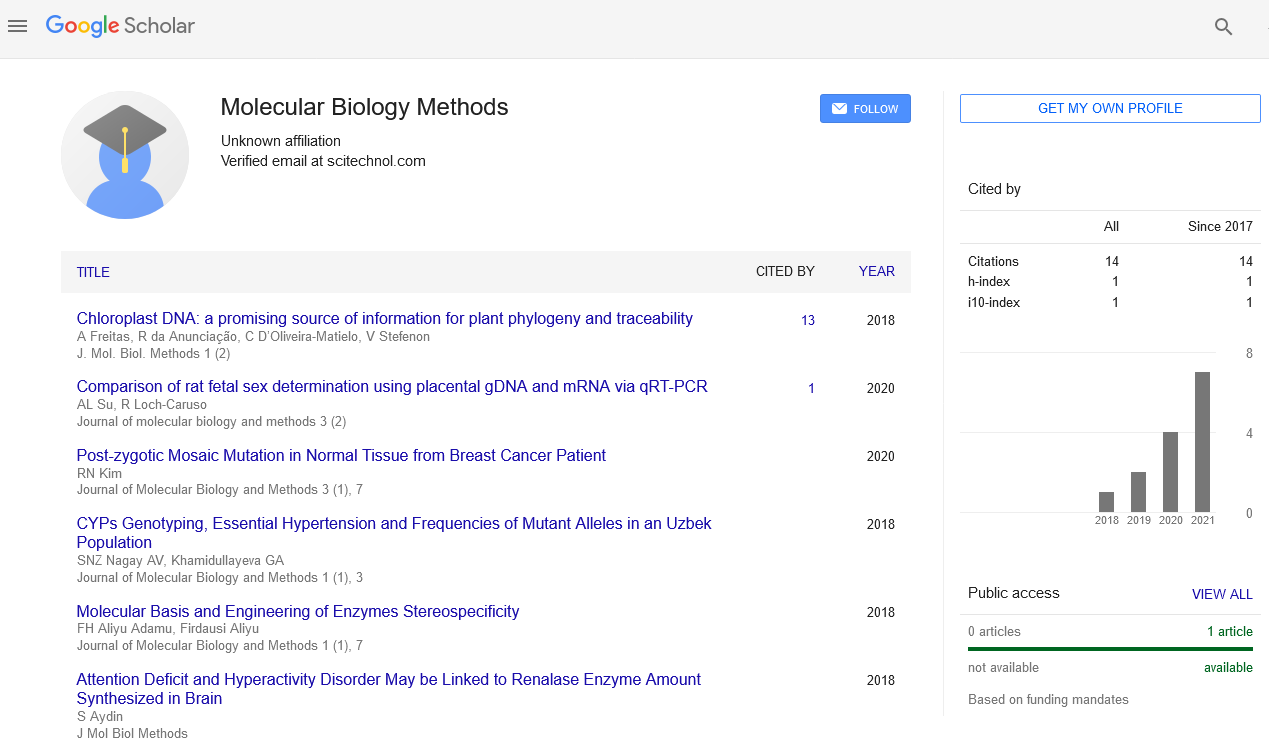Perspective, J Mol Biol Methods Vol: 5 Issue: 3
Fluorogen Activating RNA Aptamers in Living Cells
Anatoliy Kotzuruba*
Department of Entomology, Kansas State University, Manhattan, USA
Corresponding author: Anatoliy Kotzuruba
Department of Entomology, Kansas State University, Manhattan, USA
E-mail: kotzurba_a5@zed.us
Received date: 13 April, 2022, Manuscript No. JMBM-22-69815;
Editor assigned date: 15 April, 2022, PreQC No. JMBM-22-69815 (PQ);
Reviewed date: 26 April, 2022, QC No. JMBM-22-69815;
Revised date: 06 May, 2022, Manuscript No. JMBM-22-69815 (R);
Published date: 16 May, 2022, DOI: 10.4172/Jmbm.1000117
Citation: Kotzuruba A (2022) Fluorogen Activating RNA Aptamers in Living Cells. J Mol Biol Methods 5:3.
Keywords: Bioinformatics
Introduction
Signal transduction is the cycle by which a synthetic or actual sign is sent through a phone as a progression of atomic occasions, most generally protein phosphorylation catalyzed by protein kinases, which at last outcomes in a phone reaction. Proteins answerable for distinguishing boosts are for the most part named receptors, albeit sometimes the term sensor is utilized. The progressions evoked by ligand restricting (or signal detecting) in a receptor bring about a biochemical outpouring, which is a chain of biochemical occasions known as a flagging pathway. While flagging pathways connect with each other they structure organizations, which permit cell reactions to be facilitated, frequently by combinatorial flagging occasions. At the atomic level, such reactions remember changes for the record or interpretation of qualities and post-translational and conformational changes in proteins, as well as changes in their area. These sub-atomic occasions are the essential systems controlling cell development, multiplication, digestion and numerous different cycles. In multicellular creatures, signal transduction pathways manage cell correspondence in a wide assortment of ways.
Every part (or hub) of a flagging pathway is arranged by the job it plays concerning the underlying improvement. Ligands are named first couriers, while receptors are the sign transducers, which then, at that point, initiate essential effectors. Such effectors are commonly proteins and are frequently connected to second couriers, which can initiate optional effectors, etc. Contingent upon the effectiveness of the hubs, a sign can be intensified (an idea known as sign addition), with the goal that one flagging atom can produce a reaction including hundreds to millions of particles. Similarly as with different signs, the transduction of natural signs is portrayed by delay, commotion, signal criticism and feedforward and impedance, which can go from unimportant to obsessive. With the appearance of computational science, the investigation of flagging pathways and organizations has turned into a fundamental apparatus to comprehend cell capacities and sickness, including flagging overhauling instruments hidden reactions to procured drug obstruction.
Most of sign transduction pathways include the limiting of flagging atoms, known as ligands, to receptors that trigger occasions inside the cell. The limiting of a flagging atom with a receptor causes an adjustment of the conformity of the receptor, known as receptor enactment. Most ligands are dissolvable atoms from the extracellular medium which tie to cell surface receptors. These incorporate development variables, cytokines and synapses. Parts of the extracellular framework, for example, fibronectin and hyaluronan can likewise tie to such receptors. Moreover, a few atoms, for example, steroid chemicals are lipid-dissolvable and accordingly cross the plasma film to arrive at cytoplasmic or atomic receptors. On account of steroid chemical receptors, their excitement prompts restricting to the advertiser locale of steroid-responsive qualities. Not all orders of flagging atoms consider the sub-atomic nature of each class part. For instance, odorants have a place with a wide scope of atomic classes, as do synapses, which range in size from little particles, for example, dopamine to neuropeptides like endorphins. In addition, a few particles might squeeze into more than one class; epinephrine is a synapse when emitted by the focal sensory system and a chemical when discharged by the adrenal medulla.
Contingent the Effectiveness of the Hubs
A few receptors, for example, HER2 are equipped for ligandautonomous initiation when overexpressed or transformed. This prompts constitutive actuation of the pathway, which could possibly be toppled by remuneration components. On account of HER2, which goes about as a dimerization accomplice of other EGFRs, constitutive initiation prompts hyper proliferation and disease. The commonness of cellar films in the tissues of implies that most cell types expect connection to make due. This prerequisite has prompted the improvement of intricate mechanotransduction pathways, permitting cells to detect the solidness of the foundation. Such flagging is predominantly coordinated in central attachments, areas where the integrin-bound actin cytoskeleton distinguishes changes and communicates them downstream through YAP1. Calcium-subordinate cell grip particles, for example, cadherin and selections can likewise intercede mechanotransduction. Specific types of mechanotransduction inside the sensory system are liable for mechanosensation: Hearing, contact, proprioception and equilibrium.
The detecting of temperature in cells is known as thermoception and is essentially intervened by transient receptor likely channels. Also, creature cells contain a preserved system to keep high temperatures from causing cell harm, the hotness shock reaction. Such reaction is set off when high temperatures cause the separation of idle HSF1 from edifices with heat shock proteins Hsp40/Hsp70 and Hsp90. With assistance from the ncRNA hsr1, HSF1 then, at that point, trimerizes, becoming dynamic and upregulating the declaration of its objective qualities. Extracellular receptors are fundamental transmembrane proteins and make up most receptors. They range the plasma layer of the cell, with one piece of the receptor outwardly of the cell and the other within. Signal transduction happens because of a ligand restricting to the external locale of the receptor (the ligand doesn't go through the layer). Ligand-receptor restricting prompts an adjustment of the adaptation of within part of the receptor, an interaction now and again called "receptor actuation". This outcomes in either the initiation of a catalyst space of the receptor or the openness of a limiting site for other intracellular flagging proteins inside the phone, in the long run spreading the sign through the cytoplasm.
 Spanish
Spanish  Chinese
Chinese  Russian
Russian  German
German  French
French  Japanese
Japanese  Portuguese
Portuguese  Hindi
Hindi 